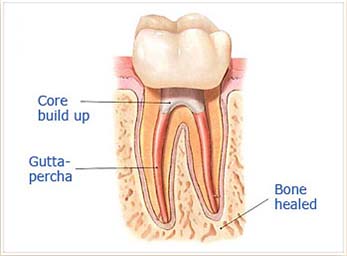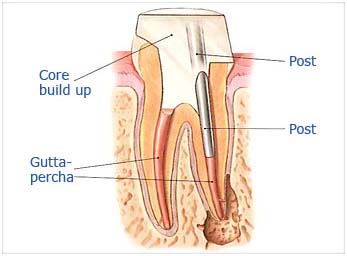Root Canal Therapy
Why would I need an endodontic procedure?
Endodontic treatment is necessary when the pulp becomes inflamed or infected. The inflammation or infection can have a variety of causes: deep decay, repeated dental procedures on the tooth or a crack or chip in the tooth. In addition, a blow to a tooth may cause pulp damage even if the tooth has no visible chip or cracks. If pulp inflammation is left untreated, it can cause pain or lead to an abscess. Signs of pulp damage include pain, prolonged sensitivity to heat or cold, discoloration of the tooth and swelling and tenderness in the nearby gum. Sometimes there are no symptoms.
How does Endodontic treatment save the tooth?
Dr. Sidi removes the inflamed or infected pulp, carefully cleans and shapes the inside of the tooth, then fills and seals the space. Afterwards, Dr. Sidi will place a crown or other restoration on the tooth to protect and restore it to full function. After restoration, the tooth continues to function like any other tooth.
Will I feel pain during or after the procedure?
Many endodontic procedures are performed to relieve the pain of toothaches caused by pulp inflammation or infection. With modern techniques and anesthetics most patient report that they are comfortable during the procedures.
For the first few days after treatment, you tooth may feel sensitive, especially if there was pain or infection before the procedure. This discomfort can be relieved with over-the-counter or prescription medications. Follow Dr. Sidi's instruction carefully.
Your tooth may continue to feel slightly different from your other teeth for some time after your endodontic treatment is completed. However, if you have severe pain or pressure, or pain that lasts more than a few weeks, call Dr. Sidi's office at 415-982-0846.
Step 1: Dr. Sidi examines and x-rays the tooth, then administers local anesthetics. After the tooth is numb Dr. Sidi places a small protective sheet called a "dental dam" over the area to isolate the tooth and keep it clean and free of saliva during the procedure.
Step 2: Dr. Sidi makes an opening in the crown of the tooth. Very small instruments are used to clean the pulp from the pulp chamber and root canals, and to shape the space for filling.
Step 3: After the space is cleaned and shaped, the Dr. Sidi fills the root canals with a biocompatible materials, usually a rubber-like material called "guttapercha." The guttapercha is placed with adhesive cement to ensure complete sealing of the root canals. In most cases, a temporary filling is placed to close the opening. The temporary filling will be removed by your dentist before the tooth is restored.
Step 4a: After the final visit with Dr. Sidi, you must return to have a crown or other restoration placed on the tooth to protect and restore it to full function.
Step 4b: If the tooth lacks sufficient structure to hold the restoration in place, Dr. Sidi may place a post inside the tooth.
Will the tooth need any special care or additional treatment?
You should not chew or bite hard on the treated tooth until you have had it restored by your dentist. The unrestored tooth is susceptible to fracture, so you should see your dentist for a full restoration as soon as possible. otherwise, you need only practice good oral hygiene, includes brushing, flossing and regular checkups and cleaning.
Most endodontically treated teeth last as long as other natural teeth. In a very few cases, a tooth that has undergone endodontic treatment fails to heal or the pain continues. Occasionally the tooth may become painful or diseased months or even years after successful treatment. Often when this happens, another endodontic procedure can save the tooth.
What causes an endodontically treated tooth to need additional treatment?
New trauma, deep decay or a loose, cracked or broken filling can cause new infection in your tooth. In some cases, a dentist may discover very narrow or curved canals that could not be treated during the initial procedure.
Can all teeth be treated endodontically?
Most teeth can be treated. Occasionally, a tooth cannot be saved because the root canals are not accessible, the root is severely fractured, the tooth doesn't have adequate bone support or the tooth cannot be restored. However, advances in endodontics are making it possible to save teeth that even a few years ago would have been lost. And, when endodontic treatment is not effective, endodontic surgery may be able to save the tooth.
What is endodontic surgery?
The most common endodontic surgical procedure is called an apicoectomy or root-end resection. When inflammation or infection persists in the end of your tooth after endodontic treatment. In this procedure, Dr. Sidi opens the gum tissue near the tooth to expose the underlying bone and the infected tissue is removed. The very end of the root is also removed and a small filling may be placed to seal the root canal. Local anesthetics make the procedure comfortable and most patients return to their normal activities the next day.
What are the alternatives to endodontic treatment?
Implant Dentistry offers an alternative that we perform when saving the tooth is not the best option.






